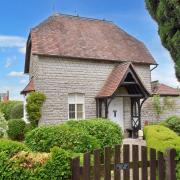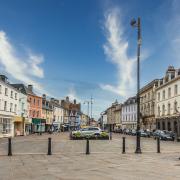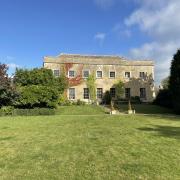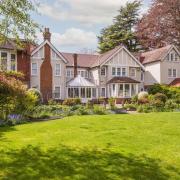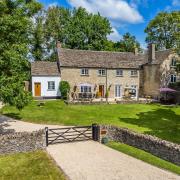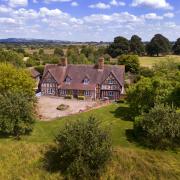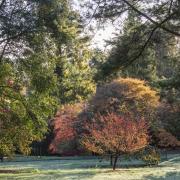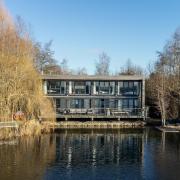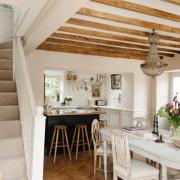With the soft September light catching the seedheads of grasses and pops of colour here and there from achillea and verbena, there’s something magical about the Dry Garden at Pontings Farm.
Winding paths offer a choice of routes, there’s drama from the architectural shape of phlomis, and the garden blends effortlessly with stunning views over the Cotswold countryside.
Yet, for many years it was an area of the one-acre garden near Stroud that Jane and Peter Randall had not quite got around to developing.

‘There was a Dutch barn here,’ recalls Jane, ‘and we always thought ‘we’ll take that down at some stage’ because all you could see was a metal building.’
It was a fire, believed to be started by internal combustion in stored hay, that finally forced their hand.
Left with a blank piece of ground, Jane asked a garden designer friend for advice: ‘I said I wanted something easy to look after but that links up to the countryside beyond, and it just does exactly that.

‘It’s lovely in the winter months when you get frost,’ she says. ‘It’s just fabulous with all the structure.’
Gravel paths weave through huge clumps of Stipa gigantea, and Miscanthus sinensis ‘Graziella’. The red-tinged seedheads of Miscanthus sinensis ‘Malepartus’ catch the light, and there are tawny shades from Miscanthus sinensis ‘Yaku-jima’.
Threaded through the grasses are fennel, phlomis, solidago and Verbenia bonariensis – Jane is planning to add the tall Aster x frikartii ‘Mönch’.
‘I want to break it up a little more with coloured dots.’

The softness of the grasses is contrasted by large pieces of moss-covered stone set into the planting. The stone was dug up during clearance work after the barn fire and is believed to date back to a house that was on the site in the 1700s.
The Dry Garden leads to Jane’s small vegetable area and greenhouse. Here she raises plants from seeds and cuttings while crops include raspberries, lettuce, sweetcorn and kale.
Sleepers have been used to make raised beds as Jane has limited mobility due to a neurological condition. Elsewhere in the garden, the couple have put in ramps to allow her to get around on her mobility scooter and she has a gardener one morning a week.

The main south-facing flower garden has been developed over the past 15 years from an uninspiring slope: ‘It was basically stinging nettles, brambles and broken glass.’
Terracing has created two useable flat levels with the top paved and the lower level as lawn and flower beds.
Deep borders run along the house walls, filled with Michaelmas daisies in shades of pink and purple, white gaura, penstemon, calendula, and Erigeron karvinskianus, all clustered around a large myrtle bush. The planting is allowed to spill over onto the paving, softening its hard edge, while gravel infills topped with pots of seasonal colour disguise manhole covers.

‘It’s quite nice to break it up rather than just be all paving.’
There’s a large ceanothus and wisteria, underplanted with sisyrinchium, alliums and Alchemilla saxatilis, a combination of leaf shapes that looks good even when there are no flowers.
‘I think it makes a beautiful ground cover.’
Along the shady side of the house, troughs and pots of ferns revel in the cool, while on the other, lifting the skirts of a group of mature pittosporum has allowed the creation of another border.

‘I love ferns and it’s shady enough so I’ve managed to get a lovely border in here with ferns and things.’
Opposite is one of the many seating areas – the garden has several benches and seats. Huge pots of cannas add an exotic feel, hylotelephium is beginning to colour, and dark purple Salvia ‘Nachtvlinder’ is set off by golden choisya. Nearby, purple berberis and Pittosporum tenufolium ‘Tom Thumb’ add structure.
On the lower level, fastigiate yew provides dramatic year-round structure while the borders are edged with neatly clipped box hedges, and filled with roses, potentilla, Verbena officinalis var. grandiflora ‘Bampton’, echinops, and a repeat of the white gaura and sisyrinchium.

‘I don’t want it all the same but it’s nice to have a few bits to bring the garden together.’
Jane’s also not afraid to change things. A huge clump of bamboo has been taken out of one border and an overgrown hebe removed from another. Both have allowed new planting to be introduced.
‘Sometimes it’s just being brave enough to dig something out.’
In one corner, water spills from a slit onto what looks like an extension of the retaining wall – ‘We didn’t want anything too elaborate and it just fits in nicely.’

A small group of silver birch were inherited with the garden and have been left as a feature in the lawn.
More silver birch are found in the wildlife area, created from ground that was overshadowed by large conifers. Removing most of those and cutting back the survivors has let in more light and allowed Jane to plant.
A small pond has been enlarged to create a wildlife pond that’s surrounded by marginals. Nearby, acers are beginning to take on their autumn shades, there are euphorbias and grasses, Hydrangea arborescens ‘Annabelle’ is still covered in large creamy flowerheads, and the wood aster is speckled in tiny white blooms.

Grass paths lead through a mix of wildflowers and perennials. The first part has persicaria, kniphofia and phlomis – echoing the Dry Garden – with more woodland plants and hellebores further on.
Recently, the couple have started to plant more trees in a lower section, including rowan, walnut and spindle, enclosing the area with a hawthorn hedge. Three large compost bins have been built and Jane is planning to use the contents to revitalise the garden borders.
Meanwhile, the wildflower area is still being refined – managing to get yellow rattle established should help to control the grass.
Gardening isn’t as easy for Jane as it once was but she is determined to keep going.
‘Even if you can just get out for half an hour and have a bit of fresh air. It’s just so important.’





